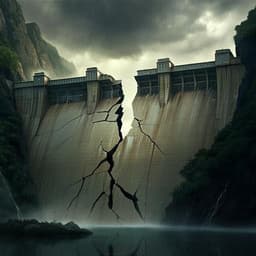
Environmental Studies and Forestry
Major changes in fish thermal habitat diversity in Canada's Arctic lakes due to climate change
D. P. Gillis, C. K. Minns, et al.
Discover how climate warming is reshaping fish communities in the Canadian Arctic lakes! This study predicts significant shifts in thermal habitats, impacting species diversity and ecosystem management. Conducted by authors Daniel P. Gillis, Charles K. Minns, Steven E. Campana, and Brian J. Shuter.
~3 min • Beginner • English
Introduction
The Arctic is experiencing amplified warming driven by cryospheric feedbacks, profoundly altering lake ecosystems that integrate atmospheric and catchment processes. Arctic lakes, largely free from non-climatic anthropogenic stressors, are sensitive sentinels of climate change, with warming patterns influenced by lake size and depth: larger, shallower lakes tend to remain thermally uniform, whereas smaller, deeper lakes stratify. Earlier ice break-up, later freeze-up, longer ice-free seasons, higher surface temperatures, and increased stratification are expected, with implications for water quality, habitat, and productivity. Arctic freshwater fish communities are dominated by coldwater species important for ecology, subsistence, and economies, and climate warming can both reduce suitability for coldwater taxa and create new opportunities, while enabling expansion of cool- and warmwater species that may compete with or invade coldwater systems. This study asks how climate-driven changes in atmospheric and catchment-level processes will alter lake thermal dynamics and, in turn, the diversity and availability of thermal habitats for fish guilds. The objectives are to (i) predict climate change impacts on seasonal thermal structure in Canadian Arctic lakes and (ii) assess consequent changes in fish thermal habitat diversity across the landscape.
Literature Review
The paper situates its work within evidence that Arctic systems are rapidly changing due to polar amplification. Prior studies show size-dependent warming and stratification responses, earlier ice break-up and later freeze-up leading to longer ice-free periods, and increasing lake surface temperatures, all affecting lake ecosystems. Projections suggest two to five week extensions of the ice-free season by mid-century, with deeper and more northerly lakes most affected. Fisheries literature indicates that warming generally disadvantages coldwater fishes, while facilitating expansions of cool- and warmwater taxa. Additional work highlights limited Arctic connectivity shaping fish diversity and the potential for Arctic lakes to serve as refugia, while noting risks from species invasions along connected basins such as the Mackenzie. The study builds on empirical and semi-mechanistic models of ice phenology, surface water temperature, and stratification (e.g., Shuter et al., Sharma et al., Gorham–Boyce, Hanna) to provide a comprehensive, landscape-scale assessment.
Methodology
Study scope: All Canadian Arctic lakes >10 ha (N = 447,077) were analyzed and summarized by eight terrestrial ecozones. Lake morphometry (area, mean and maximum depth) came from a GIS-based Arctic lake database derived from surrounding land gradients; estimates were ground-truthed against field data for 167 lakes, showing good correspondence in mean–max depth relationships. Great Bear and Great Slave Lakes were excluded from volume-days calculations due to disproportionate influence (~59% of regional limnetic volume). Climate data: Historical (1986–2005) and future (2050, 2100) climates for RCP4.5 and RCP8.5 were obtained from the Government of Canada climate data extraction tool (CMIP5-based), including monthly air temperature, precipitation, wind speed, and solar radiation adjusted for clouds; wind distributions were characterized using Weibull fits. Modeling framework: (1) Ice phenology and thickness: Empirical regression models predicted ice break-up (BU), freeze-up (FU), and winter ice thickness; lakes with winter ice thickness > mean depth were classified as barren. (2) Maximum surface water temperature: Two empirical models were applied—TMAX (triangular seasonal fit) and SWT (parabolic seasonal fit). For each lake, the average of TMAX and SWT (TMEAN) was used as maximum surface temperature; models were ground-truthed against Arctic lakes (Alexie, Vital) and Toolik Field Station datasets (RMSE ~1.55–2.56 °C). (3) Stratification and thermocline depth: The Gorham–Boyce semi-mechanistic approach linked density difference (epilimnion–hypolimnion at maximum heat content), summer storm wind stress, and fetch to predict critical mixing depth (H) and thermocline depth (h). Density differences were estimated from a regression using epilimnetic temperature and fetch; storm wind intensity distributions were approximated with a fixed Weibull shape (β = 2.338) and lake-specific scale from mean winds. A representative 2% subsample of lakes (n = 9623) was used to calibrate a single summer storm percentile (CD = 99.9999) so that the distribution of maximum depths for stratified lakes matched the Hanna-derived lower bound (Hanna Line). The same percentile was held constant for future projections, with changing mean winds adjusting storm intensity. Stratification predictions were validated using observed thermocline depths (Toolik, Alexie, Vital), yielding ~85% accuracy for presence/absence of stratification (excluding problematic shallow cases) and RMSE ~1.93–1.96 m for h. Lake classification and habitat metrics: For each scenario, lakes were classified as (i) barren (winter ice thickness > mean depth), (ii) thermally uniform (mixed during open-water), or (iii) thermally diverse (stratified during open-water), with an added density-difference filter (≥0.5 kg m⁻³) for stratification status. Daily temperature–depth profiles during the ice-free season were generated assuming a simple parabolic seasonal surface temperature curve between BU and FU with TMEAN peak at midpoint, and 4 °C hypolimnion for stratified lakes. Lake bathymetry was approximated as a cone using volume development Va = mean depth/maximum depth and partitioned into 0.1 m layers. Thermal guild definitions used adjusted thresholds aligned to Arctic species: coldwater <16 °C; coolwater 16–22 °C; warmwater >22 °C. Volume-days (m³·days) were computed for each guild and summed across the ice-free season. Establishment/persistence thresholds were applied to exclude inconsequential or transient habitats: coolwater required peak surface temperatures ≥19 °C; warmwater ≥23 °C (derived from guild distribution limits and thermal preferenda). For unstratified lakes, a coldwater persistence safeguard excluded cases where whole-lake temperatures >24 °C persisted for ≥14 days. Ecozone-level summaries were produced for ice-free volume-days and guild shares for thermally uniform/diverse lakes; barren lakes were excluded from habitat tallies.
Key Findings
Climate-driven physical changes: - Maximum lake surface water temperature increased by 2.6 °C (RCP4.5) and 6.6–6.7 °C (RCP8.5) by 2100 relative to a historical mean of 14.3 °C. By 2050, increases were +2.4 °C (RCP4.5) and +2.6 °C (RCP8.5). - Ice break-up advanced by 6.2 days (RCP4.5) and 12.4 days (RCP8.5) by 2100; freeze-up was delayed by 11.2 days (RCP4.5) and 25.1 days (RCP8.5). - The ice-free season lengthened by 17.6 days (RCP4.5) and 37.7 days (RCP8.5) by 2100 (from 104.6 days historically). In 2050: +13.5 days (RCP4.5) and +17.2 days (RCP8.5). - Increases in ice-free days were greatest in the far north (Arctic Cordillera, Northern Arctic): by 2100, +21.3 (RCP4.5) to +47.9 days (RCP8.5), roughly double the southwesterly ecozones. - Thermally stratified lakes increased from 15.8% historically to 23.8% (RCP4.5, 2100) and more than doubled under RCP8.5 (increase +34.7 percentage points). Lake-state distributions and transitions: - Barren lakes decreased numerically from 52.0% historically to 45.9% (RCP8.5, 2100), and comprised a small share of total volume (5.2% historically to 3.9% RCP8.5). Barren lakes concentrated in Northern and Southern Arctic. - Thermally diverse lakes increased in volumetric dominance from 53.0% historically to 64.4% (RCP8.5, 2100), despite being historically least numerous (14.3% to 32.5% under RCP8.5). - Thermally uniform lakes declined from 33.7% historically to 21.6% (RCP8.5, 2100); volumetric share declined from 41.7% to 31.7%. - Transitions by 2100: barren→uniform: 2.3% (RCP4.5) and 4.9% (RCP8.5) of all lakes; barren→diverse: 0.5% (RCP4.5) and 1.2% (RCP8.5); uniform→diverse: 6.7% (RCP4.5) and 17.0% (RCP8.5). Thermal habitat supply (ice-free volume-days): - Total open-water volume-days increased by +14.4% (RCP4.5) and +30.3% (RCP8.5). - Share of coldwater habitat decreased from 96.2% historically to 84.1% (RCP4.5) and 61.1% (RCP8.5). - Coolwater habitat increased from 3.8% to 15.3% (RCP4.5) and 29.5% (RCP8.5). - Warmwater habitat emerged from 0% to 0.6% (RCP4.5) and 9.4% (RCP8.5). - Ecozone extremes: Taiga Shield coldwater share dropped from 90.9% to 35.5% (RCP8.5); Southern Arctic coolwater rose to 51.7% (RCP8.5); Boreal Plains warmwater rose to 54.2% (RCP8.5). - Under RCP8.5, thermally uniform lakes became nearly equally cold vs cool (45.4% vs 42.4%), with warmwater reaching 9.4% overall. - Coldwater habitat in thermally diverse lakes remained relatively resilient overall (northern gains offset southern losses), while thermally uniform lakes shifted from cold-dominant to cool-dominant except in the far north. Management-relevant patterns: - The prevalence of thermally diverse lakes more than doubles, enhancing refuges for coldwater taxa. - Barren lakes that no longer freeze to the bottom create new potential fish habitats, most often transitioning to thermally uniform states. - Regional contrasts necessitate ecozone-specific strategies due to differing mixes of thermally uniform vs diverse systems and varying invasion risks.
Discussion
The study demonstrates that climate change will substantially lengthen ice-free periods, warm surface waters, and increase the frequency of thermal stratification across Canadian Arctic lakes. These physical changes reconfigure fish thermal habitat diversity: although coldwater habitat remains comparatively resilient in stratified lakes, thermally uniform lakes lose cold-dominance, and cool/warm habitats expand—especially under high emissions. Consequently, lakes previously inhospitable due to winter ice open up, and thermally diverse lakes, once almost exclusively coldwater, begin to support significant coolwater and some warmwater habitat, increasing the potential for competition and invasion from more southerly guilds. The results address the core questions by linking morphometry, climate drivers, and stratification to guild-specific habitat supply, revealing strong spatial heterogeneity. In the far north (Arctic Cordillera, Northern Arctic), increased thermal diversity co-occurs with sustained coldwater dominance and limited invasion pressure due to low connectivity, suggesting potential for increased productivity and sustainable harvests of native coldwater fishes. In central and southern ecozones (Taiga Plains, Taiga Shield, Boreal Plains, Southern Arctic), greater losses of coldwater habitat and gains in cool/warm habitats heighten vulnerability to invasions (e.g., via the Mackenzie Basin), necessitating monitoring and controls on introductions. Southwestern ecozones (Taiga and Boreal Cordillera) retain high thermal diversity with modest cool/warm increases, warranting targeted surveillance at potential invasion nodes. Overall, the work underscores that conservation and fishery management must account for ecozone-specific trajectories in thermal habitat diversity under climate change.
Conclusion
This paper provides a first-principles, landscape-scale assessment of how climate change will alter the thermal structure and fish thermal habitat diversity of 447,077 Canadian Arctic lakes. It integrates ground-truthed morphometry, downscaled climate projections, and empirical/semi-mechanistic models of ice, temperature, and stratification to quantify guild-specific habitat supply (volume-days) and lake-state transitions. Key contributions include evidence that (i) stratified (thermally diverse) lakes will become more prevalent and volumetrically dominant, (ii) coldwater habitat remains comparatively robust in stratified systems, and (iii) cool- and warmwater habitats will expand markedly, particularly under high emissions and in southern/central ecozones, reshaping invasion risk and management priorities. Management implications: prioritize protection of thermally diverse lakes and thermally uniform lakes that retain ample coldwater habitat; in the far north, consider potential increases in sustainable harvests; in central/southern regions, strengthen monitoring and regulation against introductions of cool/warmwater species; focus surveillance on establishment points in Taiga/Boreal Cordillera. Future research directions highlighted by the authors include: (1) incorporating under-ice winter conditions (e.g., oxygen deficits) as constraints on population viability; (2) quantifying impacts of permafrost melt and hydrological reconfiguration (slumping, drainage) on lake distributions; (3) assessing within-coldwater guild thermal diversity, including species preferring <10 °C; (4) leveraging emerging tools (eDNA) for efficient monitoring; (5) advancing process-based and variability-aware temperature/stratification models; and (6) refining guild thresholds and regional calibration of temperature models to improve predictive accuracy.
Limitations
- Modeling simplifications: seasonal surface temperature represented by idealized triangular/parabolic functions; hypolimnia assumed cold (≈4 °C) without explicit oxygen or heat content dynamics; daily and interannual temperature variability not fully represented. - Wind and stratification assumptions: a single calibrated Weibull storm percentile (CD = 99.9999) held constant across climates; potential sensitivity of stratification predictions to wind regime changes and local sheltering effects. - Model scope: approach optimized for regional, landscape-scale inference; not recommended for single-lake management decisions. - Data constraints: Toolik lakes and some Arctic sites were not sampled daily, potentially undercapturing true maxima/thermocline depths; large lakes (Great Bear, Great Slave) excluded from volume-days to avoid skew. - Parameter choices: fish thermal guild thresholds adjusted from literature and may influence habitat shares; establishment/persistence criteria (≥19 °C coolwater, ≥23 °C warmwater; >24 °C for ≥14 days coldwater exclusion in mixed lakes) affect inclusion of marginal habitats. - SWT regional correction factors (territory/province means) were not applied; could alter absolute temperature estimates. - Under-ice winter habitat constraints (e.g., oxygen) and biotic interactions beyond temperature (e.g., productivity, food webs) were not modeled; connectivity and dispersal limitations only qualitatively considered.
Related Publications
Explore these studies to deepen your understanding of the subject.







